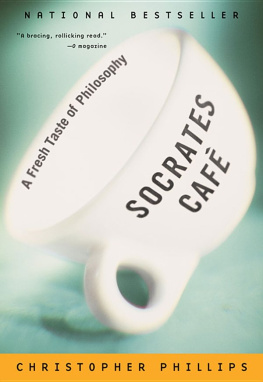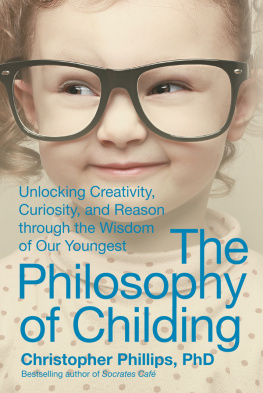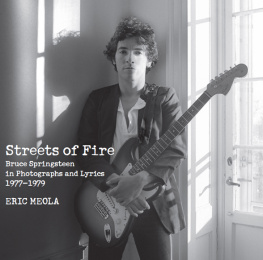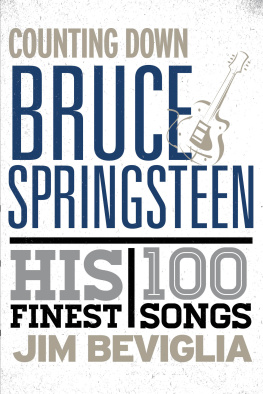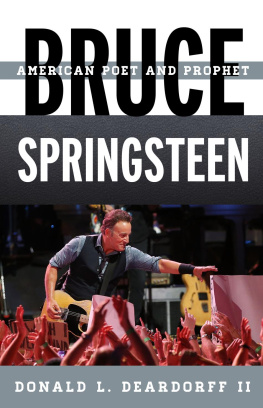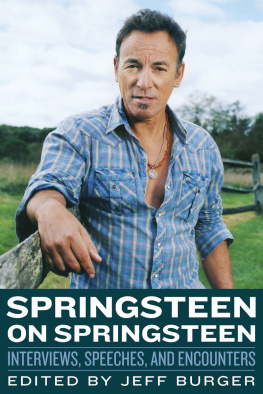
For
Lucy, Ben, and Sophie
Contents
Introduction
Christopher Phillips and Louis P. Masur
Rock n roll is my lifes bloodBruce Springsteen, 1977
Bruce Springsteens first album, Greetings from Asbury Park, N.J., appeared in January 1973. Shortly afterward he spoke to a reporter for the Asbury Park Evening Press who noted how he mumbled in a characteristically sullen manner. Asked about his future, Bruce said, Its a waste of time to think about it. Id rather think about my music.
Forty years later, thanks to that focus on his art, Bruce Springsteen stands as one of the defining artists and public figures of his generation. Time and again his work has rhymed with the times, whether Born to Run (1975), Born in the U.S.A. (1984), The Rising (2002), or Wrecking Ball (2012). He has released 17 studio albums, performed before millions of fans worldwide in marathon shows that inspire and thrill, and has become a voice for everyday people struggling with circumstance. My work has always been about judging the distance between American reality and the American dream, he told reporters in 2012.
Springsteen has taken that measure not only through his songs but also in dozens of interviews with print, radio, and television journalists. Talk is a crucial word in the Springsteen lexicon, and it appears time and again in song lyrics, whether I talk the way I wanna talk from Out in the Street, or I learned how to make it talk (his guitar, of course) from Thunder Road, or talk about a dream from Badlands. Bruce has been singing and talking about dreams his entire lifedreams of escape, community, love, and life itself. The music is well known and fully celebrated; the talk, however, has never before been collected. Bruces interviews provide a running account of the artists lifeat least those aspects he is willing to discuss, and there are few subjects that he has not eventually addressed. The interviews are key sources for understanding what Springsteen was thinking and feeling at the time.
The interviews gathered here, many of them rare and including never-before transcribed radio and television interviews, provide a multidimensional portrait of an artist of international renown. They are essential to any attempt to understand Springsteen, his work, and his place in culture. In this volume he talks to usdirectly and passionately.
For those who have heard Bruce talk about his work only recently, speaking with clarity and authority about his beliefs and experiences, it may come as a surprise that it took him a long time to become master of his own public voice, to teach himself to speak fully and intelligently, with bursts of deep insight and carefree humor. In 1974, Philadelphia DJ Ed Sciaky said to Bruce, I know you dont like to talk too much about things. Indeed, Bruce often stuttered and stammered, deflecting any serious questions to joke and goof around. Typescripts do not always capture the meaning of early interviews because we cant hear the inflection of Bruces voice, the way he swallows his words and tries to sound cool. He is fresh from the Shore, and he wants only to play music and save whatever talking he is going to do for the stage.
The fame that came with Born to Run didnt make him any more comfortable. Through the 1970s and 1980s Springsteen had an uneasy relationship with his celebrity. He mistrusted the considerable hype around him and despaired over hustling for the record machine, as he phrased it in Jungleland. But if his public voice remained restrained, his musical voice blossomed. His work began to move away from stories of youth and romance to a deeper inquiry into the struggles of survival and the everyday lives of working-class people. Musically, his composing became more tautcoiled songs that unleashed blows to head and heart. Onstage, Bruce spoke ever more openly about personal matters, such as his relationship with his father, and larger social issues such as the plight of Vietnam veterans.
The international success of Born in the U.S.A. in 1984 gave Bruce a truly massive public pulpit. He was drawn into discussing the meaning of his work when the president of the United States offered him up as example of the optimistic youth of America. Bruce, in turn, found a new voice, both in his music as well as in his interviews. Partly as a matter of growin up, partly a result of expanded horizons, Springsteen grew increasingly fluent in articulating his own vision, rather than allowing the Reagans of the world to do it for him. As his work brought him to the world stage, Springsteens casual, cool-cat patois of the 70s fully gave way to meditative, carefully observed expression (with high-pitched laughter interspersed). By 1992, a journalist observed, Springsteen has little small talk. His answers to questions are all long, often mazy and frequently beyond the reach of punctuation, but they are always answers and do betray the signs of having had some considerable thought expended on them.
He also took an inward, private turn. He married (and divorced and remarried) and became a father. He and the E Street Band separated, and the gap in interviews from the late 80s to the early 90s mirrors Bruces own withdrawal, not from the music scene but from larger-than-life iconic status. By the time he reunited with the E Street Band and heeded a call to respond to 9/11, he was prepared for another act in a career in its third decade. Springsteen embraced and enlarged his place in American culture and accepted the challenge of being a voice of conscience and commitment without losing sight of the essential joy of rock n roll played live and loud. A decade down the road, both his voice and his huge audience are steady.
Reading some of the most incisive interviews he has given over 40 years enables us to chart this development as a musician and as a public figure. These interviews offer insights into everything from the roots of his rock n roll passion, the meaning of his songs, and his performance onstage, to his childhood memories, his intellectual and emotional awakenings, and his deepening political commitment. Bruce has not spoken with a single, unchanging voice. Through the interviews, we can hear his diction change as he morphs from a young punk on the streets (and boardwalks) to a chastened rocker facing the darkness of fame to a misunderstood, pumped-up symbol of America gone awry to a husband and father and activist who in late middle age sought to make America live up to its promises. Just as his music has changed, so has he, and only through these interviews can we come to understand Springsteens various personas and his ever-evolving meaning.
Born in Freehold, New Jersey, on September 23, 1949, Bruce Frederick Joseph Springsteen, descended from Dutch, Irish, and Italian stock, had a working-class upbringing. His father, Douglas, held a variety of jobsas a factory worker in a rug mill, a bus driver, and even a prison guard for a spell. His mother, Adele, was employed as a legal secretary. Bruces younger sisters, Virginia and Pamela, were born in 1950 and 1962 respectively.
Springsteen attended parochial school at St. Rose of Lima through eighth grade, from 1954 to 1963, and graduated from Freehold High School in 1967. By all accounts he was an outsider, a loner whom his teachers did not understand. A screw-up, in a small town is how he later described himself. While the vocabulary of religious training permeates his work (sin, redemption, salvation, promised land), the experience of parochial school left its marks. I hated school, he recalled in 1978. I had the big hate. Freehold High wasnt any better. Nearly 40 years after he graduated, he was given an award in absentia and sent along an acceptance speech: My advice to teachers today is to keep your eyes on the ones who dont fit in. Those are the ones that can think out of the box. Youll never know where theyll be going.
Next page

